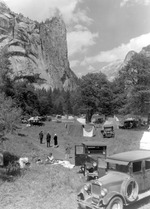 Camping at Stoneman Meadow, Spring 1927. COURTESY NPS, YNIN THE SPRING OF 2010, with the waterfalls in full gush and snow still on the trees, the Mariposa and Tuolumne County Boards of Supervisors announced a decision to honor John Muir — adventurer, writer, conservationist, Sierra Club founder — by designating a section of CA Highway 132 (from CA 49 in Coulterville to CA 120) the "John Muir Highway."
Camping at Stoneman Meadow, Spring 1927. COURTESY NPS, YNIN THE SPRING OF 2010, with the waterfalls in full gush and snow still on the trees, the Mariposa and Tuolumne County Boards of Supervisors announced a decision to honor John Muir — adventurer, writer, conservationist, Sierra Club founder — by designating a section of CA Highway 132 (from CA 49 in Coulterville to CA 120) the "John Muir Highway."
A formal dedication ceremony had been arranged, to feature John Muir’s great grandson, Bill Hanna, and famed John Muir impressionist, Lee Stetson.
"Personally," wrote Loyd Schutte, of the Yosemite Blog, "I think naming a road 'in honor' of a man who fought so hard against the destruction and urbanization of wild places is in poor taste and a shameless media ploy."
"I agree it's ironic," wrote Yosemite videographer Steven Bumgardner, "but I don't remember JM ever complaining about roads. He wasn't anti-development. He just wanted city folk to go to the country every once and a while."
So what did old John O' the Mountains, the father of the American Conservation movement, think of cars and roads? Well, it's not so cut and dried. Fact is, as prescient as he was, he may not have anticipated the extent to which the automobile would take over American culture — and the park he had fought so hard to create and protect.
Here's a note Muir wrote to Howard Palmer of the American Alpine Club in 1912, summarizing discussions at the National Parks Conference the previous October, on whether or not to allow cars in Yosemite and what sort of development might be needed in order to accomodate all those visitors who, in Muir's words, "have to be rolled on wheels with blankets and kitchen arrangements."
Martinez, Cal.
December 12, 1912
Mr. Howard Palmer:
Secretary American Alpine Club
New London, Conn.
Dear Sir:
At the National Parks conference in Yosemite Valley last October, called by the Honorable Secretary of the Interior, comparatively little of importance was considered. The great question was, "Shall automobiles be allowed to enter Yosemite?" It overshadowed all others, and a prodigious lot of gaseous commercial eloquence was spent upon it by auto-club delegates from near and far.
The principal objection urged against the puffing machines was that on the steep Yosemite grades they would cause serious accidents. The machine men roared in reply that far fewer park-going people would be killed or wounded by the auto-way than by the old prehistoric wagon-way. All signs indicate automobile victory, and doubtless, under certain precautionary restrictions, these useful, progressive, blunt-nosed mechanical beetles will hereafter be allowed to puff their way into all the parks and mingle their gas-breath with the breath of the pines and waterfalls, and, from the mountaineer's standpoint, with but little harm or good.
In getting ready for the Canal-celebration visitors the need of opening the Valley gates as wide as possible was duly considered, and the repair of roads and trails, hotel and camp building, the supply of cars and stages and arrangements in general for getting the hoped-for crowds safely into the Valley and out again. But the Yosemite Park was lost sight of, as if its thousand square miles of wonderful mountains, cañons, glaciers, forests, and songful falling rivers had no existence.
In the development of the Park a road is needed from the Valley along the upper cañon of the Merced, across to the head of Tuolumne Meadows, down the great Tuolumne Cañon to Hetch-Hetchy valley, and thence back to Yosemite by the Big Oak Flat road. Good walkers can go anywhere in these hospitable mountains without artificial ways. But most visitors have to be rolled on wheels with blankets and kitchen arrangements.
Of course the few mountaineers present got in a word now and then on the need of park protection from commercial invasion like that now threatening Hetch-Hetchy. In particular the Secretary of the American Civic Association and the Sierra Club spoke on the highest value of wild parks as places of recreation, Nature's cathedrals, where all may gain inspiration and strength and get nearer to God.
The great need of a landscape gardener to lay out the roads and direct the work of thinning out the heavy undergrowth was also urged.
With all good New Year wishes, I am Faithfully yours
John Muir